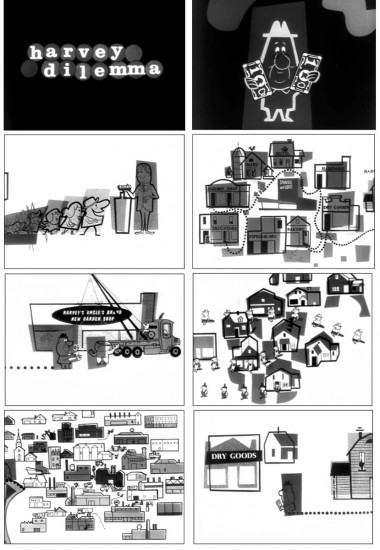We spoke with Martino about merging the worlds of 2D and 3D animation, and why a Charlie Brown who is actually recognized and praised isn't much of a stretch for Schulz.
Add a CommentViewing: Blog Posts Tagged with: Bill Melendez, Most Recent at Top [Help]
Results 1 - 7 of 7
Blog: Cartoon Brew (Login to Add to MyJacketFlap)
JacketFlap tags: Peanuts, Charles Schulz, Bill Melendez, Blue Sky Studios, Award Season Focus, Steve Martino, The Peanuts Movie, Interviews, Add a tag
Blog: Cartoon Brew (Login to Add to MyJacketFlap)
JacketFlap tags: A Charlie Brown Christmas, Blue Sky Studios, Bryan Schulz, Cornelius Uliano, Craig Schulz, Steve Martino, The Peanuts Movie, Feature Film, Peanuts, Charles Schulz, Talkback, Bill Melendez, Add a tag
Charles Schulz's Charlie Brown always failed, then triumphed, then failed, and so on. According to critics, "The Peanuts Movie" pretty much does the same.
Add a CommentBlog: Cartoon Brew (Login to Add to MyJacketFlap)
JacketFlap tags: A Charlie Brown Christmas, Blue Sky Studios, Bryan Schulz, Cornelius Uliano, Craig Schulz, Steve Martino, The Peanuts Movie, Feature Film, Peanuts, Charles Schulz, Talkback, Bill Melendez, Add a tag
Charles Schulz's Charlie Brown always failed, then triumphed, then failed, and so on. According to critics, "The Peanuts Movie" pretty much does the same.
Add a CommentBlog: Cartoon Brew (Login to Add to MyJacketFlap)
JacketFlap tags: Classic, Peanuts, Charles Schulz, Bill Melendez, A Charlie Brown Christmas, Blue Sky Studios, Lee Mendelson, United States Postal Service, Add a tag
Blog: Cartoon Brew (Login to Add to MyJacketFlap)
JacketFlap tags: Bill Melendez, Blue Sky Studios, Bryan Schulz, Cornelius Uliano, Craig Schulz, Steve Martino, CGI, Feature Film, Peanuts, Charles Schulz, Add a tag
Ahead of the film's teaser trailer premiere later today, we've got our first look at the bigscreen CGI adaptation of "Peanuts" that is being produced by Blue Sky Studios.
Add a CommentBlog: Cartoon Brew (Login to Add to MyJacketFlap)
JacketFlap tags: Bill Melendez, Ed Levitt, Disney, Animators, RIP, Peanuts, Bambi, Fantasia, Snow White and the Seven Dwarfs, Add a tag
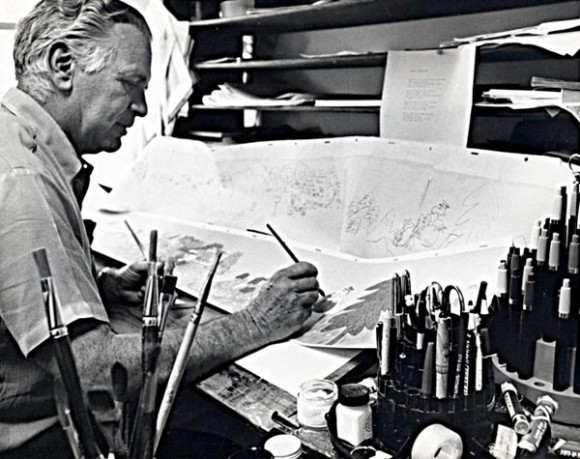
Edward Levitt, an unsung hero of the Golden Age of animation, has died. He was 96. Levitt died on Tuesday, April 2, in Palmdale, California.
Levitt worked as a production designer, storyboard and layout artist, and background painter for thirty-five years in the animation industry. His superb skills as a designer made him a key figure during the Cartoon Modern era of the 1950s.
Ed Levitt was born in New York City on April 17, 1916 and grew up in Somers, Connecticut and Brooklyn, New York. His family moved to Los Angeles in the mid-1930s and following graduation from high school, Levitt applied to the Disney Studios in 1937. He was hired at $16.50 per week and did rotoscape tracing on Snow White and the Seven Dwarfs.
The Disney studio recognized his talent as a painter, and by the end of production on Snow White, he had switched to painting backgrounds. He worked as a background artist on Pinocchio, the “Rite of Spring” segment in Fantasia and Bambi. Levitt picketed during the Disney strike of 1941. He returned after the strike was settled to work on Victory Through Air Power, but left again to enlist in the Marines in 1943. During the war, he made training films while a member of the Marine Corps Photographic Section in Quantico, Virginia.
Here are a couple examples of his paintings from Fantasia and Bambi:
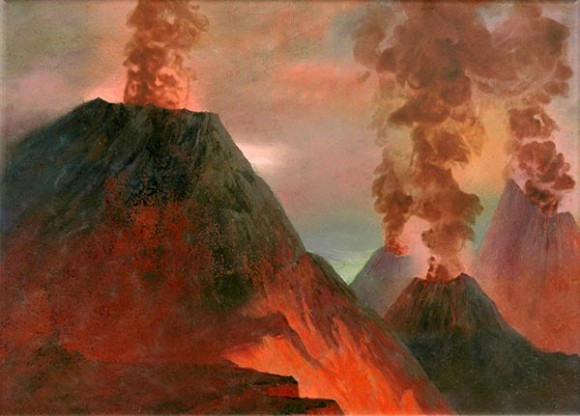
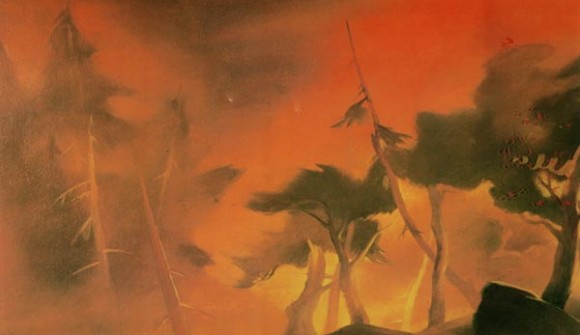
After the war, Levitt became a partner in a Los Angeles-based production company called Cinemette, which was formed with ex-Marines (and Disney artists) John Chadwick, Jack Whitaker, and Keith Robinson. The studio operated between 1946-1950, and they created a number of industrial films, as well as entertainment short subjects and early TV commercials.
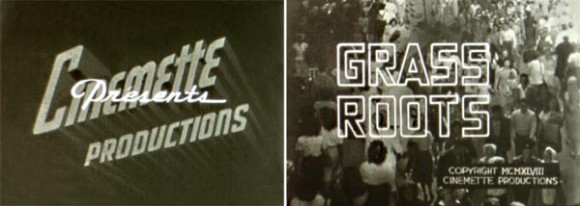
Levitt’s liberal politics led him to direct Grass Roots (1948), which called for establishing a world government through a revision of the United Nations charter and was partly funded by the United World Federalists. He also produced a popular anti-nuclear film Where Will You Hide? (1948), which attracted the attention of no less than Albert Einstein, who commented, “Somebody, after having seen this film, may say to you: This representation of our situation may be right, but the idea of world government is not realistic. You may answer him: If the idea of world government is not realistic, there there is only onerealistic view of our future: wholesale destruction of man by man.”
Levitt’s star rose during the 1950s when commercials and commissioned films were produced at an increasingly frenetic pace. His graphically accessible yet sophisticated style made him much sought after as a designer, storyboard and layout artist. “He was a great artist,” said animator Bill Littlejohn. “And his layouts were the best. He could animate, too. I sure liked working with him. He was so damn good at what he did. He knew the problems that the animators would face and he would design things with that in mind.”
These are a few examples of commercials and films designed and laid out by Levitt: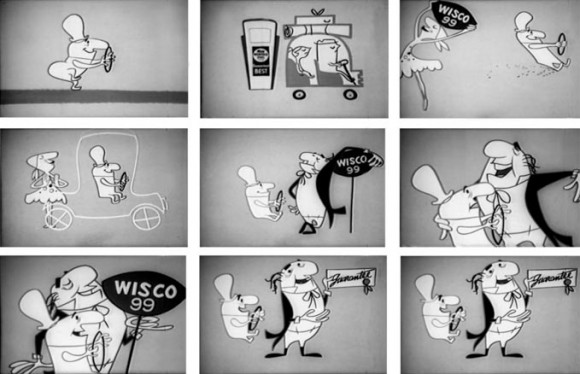
Through the 1950s, Levitt worked as a freelancer at more than a dozen studios including Graphic Films, Cascade Pictures, Raphael G. Wolff, Quartet Films, John Sutherland Productions, Eames Office, ERA Productions, United Productions of America, Ray Patin Productions, Academy Pictures, Churchill/Wexler Film Productions, Storyboard Inc., and Fred A. Niles Productions.
At Playhouse Pictures, Levitt worked closely with director Bill Melendez on many of the Ford spots starring the cast from the Peanuts comics. When Melendez opened his own studio in 1964, Levitt was one of the first artists he hired. “I remember Ed as being reliable, steady, pragmatic, kind and generous,” said Melendez’s son Steve, who also worked at the studio. “I know that he helped Bill in the early days not only artistically but also financially. Bill always considered Ed to be ‘The Best’, a title he did not bestow easily or often. Ed could draw anything and had a great grasp of how a film is made. He was the best layout person I have ever met.”
Levitt played a key role in designing the first Peanuts special, A Charlie Brown Christmas with backgrounds like this:
He also coined the famous credit used for many years at the end of the Peanuts specials—Graphic Blandishment. “Blandishment” is defined as “something that tends to coax or cajole,” which speaks to Levitt’s modesty and his view of the role he played in the filmmaking process.
Steve Melendez recalled that Levitt was proud of A Charlie Brown Christmas even during times of uncertainty and doubt:
“When we completed A Charlie Brown Christmas, and we all had a chance to look at the answer-print, Bill, Lee [Mendelson] and everyone else thought we were the authors of a great disaster and we would probably never make a film again. Ed was the sole voice who said, ‘Don’t be silly, this film will be shown for a hundred years!’ And he was right. I don’t know if he believed it or not, but his calm confidence gave everyone hope that perhaps things were not as bad as they seemed.”
By the early-1960s, Ed identified himself as a Cartoonist-Rancher on his income tax returns. He had begun taking animal husbandry classes at Pierce College, and had purchased a ranch in Lake Hughes, an hour’s drive north of Los Angeles, near Gorman, California. There, he planted cherry and apple orchards, and began to raise cattle.
Bill Melendez made this drawing of “cartoonist-rancher Ed”: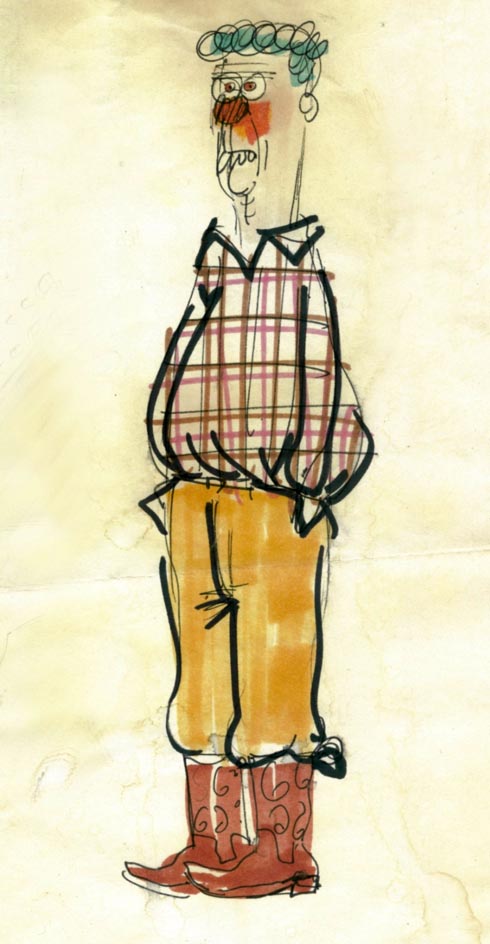
He spent most of the 1960s working on the Charlie Brown TV specials, and also directed a couple of Babar specials for Melendez. Other Sixties projects included the titles of It’s a Mad Mad Mad Mad World, and the features Gay Purr-ee and The Incredible Mr. Limpet.
Levitt retired from animation in 1973 to become a full-time rancher and orchard owner. “As you get older,” Levitt told a newspaper reporter, “it just seems a lot nicer to sit up here in the forest and listen to the trees grow.”
Levitt is predeceased by his wife, Dorothy. He is survived by his brother, Julius Levitt; sister, Annette Priemer; his four children, Alan Cyders; Geoffrey, Dan and Paul Levitt, along with numerous grandchildren and great-grandchildren. In lieu of flowers, the family has requested that donations be made in his name to the Motion Picture & Television Country House and Hospital.
Add a CommentBlog: Cartoon Brew (Login to Add to MyJacketFlap)
JacketFlap tags: Charlie Brown, Bill Melendez, Charles Solomon, Books, Peanuts, Add a tag
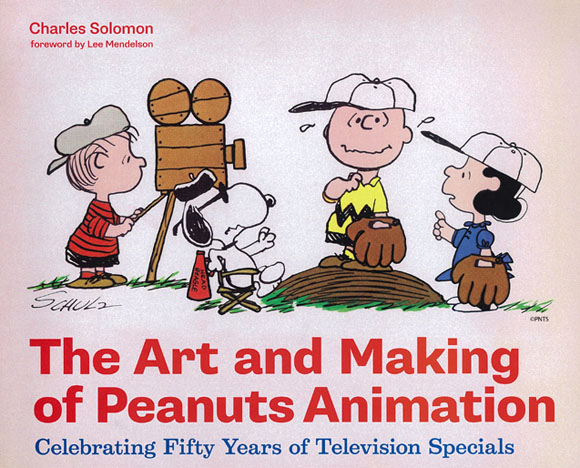
I’ll be posting a Holiday Gift Guide next month, but one book leapt out of the pack and I want to give you the heads-up right now. I just received a copy of Charles Solomon’s The Art and Making of Peanuts Animation (Chronicle Books) and found it a wonderful surprise.
Not only a visual delight – original cels, backgrounds, storyboards, animation drawings, Schulz model sheets and scripts, behind the scenes photos, television station publicity materials – but Solomon’s text is goes deep into the making of these landmark specials (and theatrical features) with new information and interviews with noted participants, including Lee Mendelsohn, Phil Roman, the late Bill Melendez and Bill Littlejohn – and many others including the voice actors. The text is loaded with great inside information and I particularly appreciated how Solomon tied the influences of UPA and earlier animation to the Peanuts specials – and how these Charlie Brown specials have influenced important directors and creators of animation working today.
The bottom line: the book is great fun and highly informative. I never thought a book about Peanuts specials could be so enlightening and entertaining. Bravo, Mr. Solomon, the Schulz estate and the editor/designers at Chronicle for a job well done. You’ve done Mr. Schulz and Mr. Brown proud. The book goes on sale Nov. 14th.
In conjunction with the publication of this book, the Schulz Museum in Santa Rosa California is hosting an exhibition of rare animation art over this holiday season. Don’t miss an appearance and panel with Producer Lee Mendelsohn and author Charles Solomon on Saturday December 1st to discuss the films. Here’s the Museum’s Press release:
The Charles M. Schulz Museum and Research Center is highlighting the artifacts that made this possible with an exhibition featuring 16 original never-before-displayed Peanuts animation drawings and cels, including five cels rescued from Schulz’s 1966 studio fire.
The Art of Peanuts Animation: Production Cels from the Museum’s Collection runs now through Sunday, February 3, 2013. Timed to coincide with the November 7, 2012 launch of the new Chronicle book The Art and Making of Peanuts Animation by Charles Solomon, this exhibit includes rare original production cels from animated Peanuts classics: A Charlie Brown Christmas; It’s the Great Pumpkin, Charlie Brown; and A Charlie Brown Thanksgiving. Visitors will also see cels from numerous other animated specials from the 1960s, 1970s, and 1980s, and view selected full-length animated specials in the Museum’s theater.
Rare Cels Survive Fire at Schulz’s Studio
Several of the animation cels in the Museum’s collection survived a fire at Schulz’s Coffee Grounds Studio in 1966. These original cels from the animated television specials It’s the Great Pumpkin, Charlie Brown and A Charlie Brown Christmas were donated to the Museum by a childhood friend of Schulz’s son, Craig, who recovered the cels from the studio after the fire.Programming Events:
Saturday, December 1 at 1:00 pm
Join Lee Mendelson, executive producer of the classic Peanuts animated specials, and Charles Solomon, internationally respected animation historian and author of the new Chronicle book The Art and Making of Peanuts Animation, as they talk about the making of Peanuts animated specials.ABOUT THE CHARLES M. SCHULZ MUSEUM AND RESEARCH CENTER
The Charles M.SchulzMuseum opened in August 2002 to fulfill its mission of preserving, displaying, and interpreting the art of Charles M. Schulz. The museum carries out this mission through changing exhibitions and programming that: build an understanding of cartoonists andcartoon art; illustrate the scope of Schulz’s multi-faceted career; communicate the stories, inspirations and influences of Charles Schulz; and celebrate the life of Charles Schulz and the Peanuts characters.LOCATION
The Charles M. Schulz Museum is located 50 minutes north of San Francisco by car on Highway 101. The Museum is located at 2301 Hardies Lane, Santa Rosa, California, 95403.HOURS
Weekdays Monday thru Friday (except Tuesdays*) 11am – 5pm
Saturday & Sunday 10am – 5pm
Closed Tuesdays*
*Open every day throughout the summer (Memorial Day through Labor Day)ADMISSION FEES
Free – Museum Members, Children 3 and under
$5.00 – Children 4-18, college students with valid I.D. card, and Seniors 62+
$10.00 – AdultsCharles M. Schulz Museum & Research Center • 2301 Hardies Lane Santa Rosa, CA 95403
Here’s a trio of original cels in the book – and now on display at the Schulz Museum (click to enlarge):


 Add a Comment
Add a Comment




